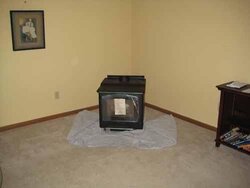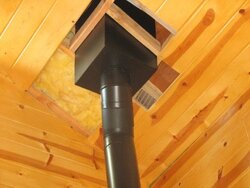Hi guys,
I'm starting to put together my plans for building the hearth pad for my new 30-NC. I called the county to inquire about codes. They instructed me to install the stove acording to the manufacturers specs. They confirmed that they do not have any codes that override the instructions.
I want to make sure that I am understanding the instructions correctly. The stove will be a corner installation. The way I understand it, I must measure perpendicular from the wall to the corner of the stove at least 15" away. If I stay at least 15" perpendicular from the walls, I do not need to install anyting over the existing drywall. The stove pipe from the stove to the connector at the ceiling needs to be 20.5" minimum away from the walls.
What do you guys suggest from the stove to the ceiling connector? Single wall or double wall? Will the draft be easier to start with a single wall pipe (closer to the room temp when starting the stove)? Will I reclaim any extra heat with single wall? Is single wall less safe than double wall for this purpose?
On the hearth wiki, I noticed that the rule has changed from 16" to 18" of hearth extending in front of the stove. Where do I measure from? From the front face of the stove? From the front face of the door? From the edge of the lip that protrudes under the door?
As far as how the pad hearth pad itself is built, I really liked what I saw in another thread this past week. Using closely spaced metal studs mated together to add strength for the framing with durock and tile over top is the way I'm going to go. The hearth wiki says that dead air space of 1" has an R value of .97. If I use metal studs, I will have approxmately 3.5" of dead air space. What is the R value of 3.5" of dead air space?
The manual says that the floor protection needs to have an R value of 1.5. Acording to the hearth wiki, I can achieve that as follows (using the R value for 1" of dead air since I don't know the R value for 3.5"):
Dead air @ R .97
Two layers 1/2" durock board @ R .26 each
One layer of 1/4" ceramic tile @ R .01
Total R value comes to R 1.5
We set the stove down in the corner where we are going to install it. I took some towels and layed them on the floor to aproximate the footprint of the hearth pad so that my wife and I could get a feel for how it will look (the hearth pad will go all the way back to the corner). The photo looks very flat (almost no depth perception) but everything is sitting according to the clearances as I understood them to be.
-SF
I'm starting to put together my plans for building the hearth pad for my new 30-NC. I called the county to inquire about codes. They instructed me to install the stove acording to the manufacturers specs. They confirmed that they do not have any codes that override the instructions.
I want to make sure that I am understanding the instructions correctly. The stove will be a corner installation. The way I understand it, I must measure perpendicular from the wall to the corner of the stove at least 15" away. If I stay at least 15" perpendicular from the walls, I do not need to install anyting over the existing drywall. The stove pipe from the stove to the connector at the ceiling needs to be 20.5" minimum away from the walls.
What do you guys suggest from the stove to the ceiling connector? Single wall or double wall? Will the draft be easier to start with a single wall pipe (closer to the room temp when starting the stove)? Will I reclaim any extra heat with single wall? Is single wall less safe than double wall for this purpose?
On the hearth wiki, I noticed that the rule has changed from 16" to 18" of hearth extending in front of the stove. Where do I measure from? From the front face of the stove? From the front face of the door? From the edge of the lip that protrudes under the door?
As far as how the pad hearth pad itself is built, I really liked what I saw in another thread this past week. Using closely spaced metal studs mated together to add strength for the framing with durock and tile over top is the way I'm going to go. The hearth wiki says that dead air space of 1" has an R value of .97. If I use metal studs, I will have approxmately 3.5" of dead air space. What is the R value of 3.5" of dead air space?
The manual says that the floor protection needs to have an R value of 1.5. Acording to the hearth wiki, I can achieve that as follows (using the R value for 1" of dead air since I don't know the R value for 3.5"):
Dead air @ R .97
Two layers 1/2" durock board @ R .26 each
One layer of 1/4" ceramic tile @ R .01
Total R value comes to R 1.5
We set the stove down in the corner where we are going to install it. I took some towels and layed them on the floor to aproximate the footprint of the hearth pad so that my wife and I could get a feel for how it will look (the hearth pad will go all the way back to the corner). The photo looks very flat (almost no depth perception) but everything is sitting according to the clearances as I understood them to be.
-SF



